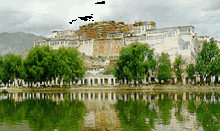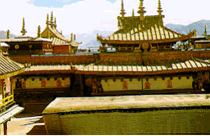Tibet
 Tibet lies on the Qinghai-Tibet Plateau of the southwest border of China. The average height of the whole region is more than 4,000 meters above sea level, for which Tibet is known as "Roof of the World". The highest peak of Tibet, also the highest in Himalayas and in the whole world, is Everest Peak, which is as high as 8,846.27 meters above sea level.
Tibet lies on the Qinghai-Tibet Plateau of the southwest border of China. The average height of the whole region is more than 4,000 meters above sea level, for which Tibet is known as "Roof of the World". The highest peak of Tibet, also the highest in Himalayas and in the whole world, is Everest Peak, which is as high as 8,846.27 meters above sea level.
Although a part of China, Tibet has a unique culture of all there own. It is mainly inhabited by Tibetans, a minority nationality of old and mysterious people. Tourist attractions include the Potala Palace in Lhasa, Jokhang Temple, and a number of Buddhist sacred places.
Tibet (Xi Zang in Chinese) is to the south of Xin Jiang Uygur Autonomous Region and Qing Hai Province, to the west of Sichuan, to the northwest of Yunnan and to the north of India and Nepal. Its population of 2.3 million people come from a variety of ethnic groups including Tibetan, Han, Monba and Lhota. Its capital city is Lhasa.
Northwest Tibet, mainly Qing Hai plateau, is home to a variety of unusual and unique animals. Across the northern expanse of Tibet, you can see vast grasslands where horses, cattle and sheep roam freely. The world's lowest valley, the Grand Yarlun-tzanpo River Valley lies in east Tibet.
Nearly all Tibetans follow Tibetan Buddhism, known as Lamaism, with the exception of approximately 2,000 followers of Islam and 600 of Catholicism. Tibetan Buddhism was greatly influenced by Indian Buddhism in its early time, but after years of evolution, Tibetan Buddhism has developed its own distinctive qualities and practices. A well-known example is the belief that there is a Living Buddha, who is the reincarnation of the first, a belief alien to Chinese Buddhism.
It is freezing cold in most time of the year. Most tourists come to visit Tibet only in the warmest seasons, June, July, August and early September.
Recommended Scenic Spots
Potala Palace
In 641, after marrying Princess Wencheng, Songtsen Gampo decided to build a grand palace to accommodate her and let his descendants remember the event. However, the original palace was destroyed due to a lightening strike and succeeding warfare during Landama's reign. In seventeenth cen tury under the reign of the Fifth Dalai Lama, Potala was rebuilt. The Thirteenth Dalai Lama expanded it to today's scale. The monastery-like palace, reclining against and capping Red Hill, was the religious and political center of old Tibet and the winter palace of Dalai Lamas. The palace is more than 117 meters (384 feet) in height and 360 (1180 feet) in width, occupying a building space of 90 thousand square meters. Potala is composed of White Palace and Red palace. The former is for secular use while the later is for religious.
tury under the reign of the Fifth Dalai Lama, Potala was rebuilt. The Thirteenth Dalai Lama expanded it to today's scale. The monastery-like palace, reclining against and capping Red Hill, was the religious and political center of old Tibet and the winter palace of Dalai Lamas. The palace is more than 117 meters (384 feet) in height and 360 (1180 feet) in width, occupying a building space of 90 thousand square meters. Potala is composed of White Palace and Red palace. The former is for secular use while the later is for religious.
Jokhang Temple

Jokhang Temple has been a place of pilgrimage for centuries. It is the spiritual center of Lhasa and stands in the heart of the old city. It was built in 647AD by King Songtsen Gampo, upon establishing his kingdom's capital in Lhasa. Through several renovations it expanded into quite a large group of buildings and now covers an area of over 25,000 sq meters.
Jokhang has 4 stories and its roofs are covered with gilded bronze tiles. It was built in the style of Tang dynasty structures and adopted the characteristics of Nepalese and Indian architecture.
There are numerous elaborately decorated shrines and rooms at Jokhang. There are also statues of King Songtsan Gambo together with his Chinese bride Princess Wen Cheng and Nepalese bride Princess Chizun in the side halls. In the center of the main hall, a gold statue of the young Buddha Sakyamuni, brought to Tibet by Princess Wen Cheng from Chang'an (present Xian) is enshrined.













No comments:
Post a Comment